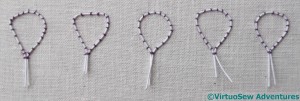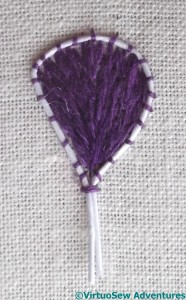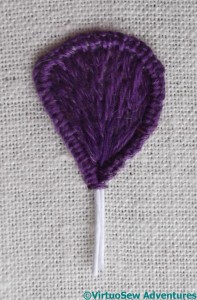Banafsiga – Violets
In her book, Mary Chubb describes the sort of frustrating experience that many language learners will recognise, in which a word completely useless for present practical purposes somehow sticks in the mind, while the immediately useful and necessary words just don’t. In her case, she says that while the Arabic word for “bread” required constant effort to remember, for some reason the word for “violet”, transliterated in her book as “banafsiga”, in her words “perched, fragrantly and effortlessly in my brain from the start“.
Naturally, I’m going to have to do some violets to represent the experience, and I’ve decided to do them in stumpwork. I’ve done a little raised embroidery – I suppose those fellows Loading The Felucca count, and there’s always the Kiwi – but wired stumpwork is new. I won’t claim to be approaching it full of trepidation, because no-one would believe me, but I certainly have no idea which bits I will find easy and which I will find hard.
Actually, as it turned out, the first difficulty lay in working out what a violet should look like. I wanted the simple, old-fashioned violets that Mary, brought up in the early twentieth century, might have known, and my image sources online kept on introducing African Violets, which apparently aren’t the same thing at all.
In the end, following a suggestion from a Twitter friend, I went rummaging on the RHS website, and found a complete rundown on viola odorata, which told me it has five petals, heart-shaped leaves, and is “mat-forming”, which I take to mean it spreads out rather than up. I don’t know how many flowers or leaves my bunch will have in it, so I’m expecting to do more than I need and pick the best.
I’m using ordinary stranded cotton on this occasion (“Gosh“, I hear you cry, “What happened to all the eccentric yarns you use?“, to which I reply, “There’s paper-covered wire in there – what more do you want?“), and in this first flower, I’m going to use two strands for the embroidery. If I think it looks a bit chunky, I can always move on to single strand for subsequent flowers.
Thus far, I’m rather enjoying it. I may yet move on from these violets to the wired needlelace rose I saw in a Needlecraft magazine twenty-five years ago, and never got around to…





Looks like fun! I’ll have to give stumpwork a try one day.
What an exciting adventure. I love your quests and the stitcheries that follow and can’t wait to see these lovely little flowers all assembled.
I love the reference! Ah, this is taking me back to my stump work days gone by.The violet lends itself beautifully as a basis for wired work.
What a delightful way to explain how the word for violet entered her consciousness! Can’t wait to see your violets materialize!
Well done o Venturesome One. One day, I’ll get a round tuit for stumpwork (but nobody hold their breath!) but I’d be even more scared than you. I’d love to see the needlelace rose too… (hint, hint)
Words can be used to paint beautiful pictures and Mary Chubb seems to be able to use them well. Looking foward to seeing the finished violet.
I can sympathise with your quest for pictures of ‘proper’ violets on the internet. My own attempt at violets in silk began with exactly the same frustration. I tend to search for the Latin name and botanic drawings if I want useful information on how plants look, having learnt by this experience.
I enjoy reading your blog for the various techniques and explanation.
I do love the skeletal like structures in the top two images Rachel….
Have just bought RSN book on stumpwork (from Trerice NT house where there is some fabulous stumpwork) so will be intrigued to see the progress. Good luck.
I like the leaves – they look like hearts!
What a lovely story! You have a real talent for finding the little lanes and byways of a tale and exploring them in stitch.
I have never tried stumpwork …….. but as I have so much on the go, I shall just resist the temptation to have a go, and watch your progress instead!
Ooh, this all looks rather intriguing! Needless to day, not being a sewing person really, I have never heard of ‘stumpwork’, but that is definitely a word which will stick in my head for days! xCathy
Your stitching looks great! I look forward to seeing this flower finished.
A lady, whose name escapes me (Kay ?) and her husband visited my handicraft group soon after I joined the group. I found her talk fascinating, but haven’t tried stump work, yet! Barbara xx